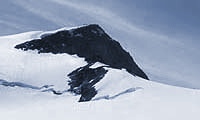|
What is a glacier?
The word glacier means ice and has a history from Latin. In our neighbor country Norway they say "bre" and in Iceland they use the word "jökel".
A glacier is an ice mass which moves along the mountains. The movements of the ice masses is important, in other case you can't classify it like a glacier. An ice crystal in our Swedish Mountains will be transported through the ice, and that could take thousands of years.
|

|
|
|
When the ice is moving it'll become friction against the ground and finally gravel's will follow with the ice to the end of the glacier where you can see these moraine formations.
Sometimes you meet nearly the same type of moraines on the glacier, and then it lays parallel with the glacier.
|
|
|
There will be lot of tensions when the ice is moving which leads to cracks. Most sensitive are areas where the glacier changes direction or when the leaning of the ground changes. At the top of the glacier beneath the ground a crack will be found.
Glacier wells are rather tricky for the hiker, you don't see them but maybe hear them. When melt water is pouring through the ice it will be small streams. They become bigger and bigger towards the end of the glacier. And then when the crack will close a well could be made. If you fall down you don't survive.
|
|
|
You find several variants in which a glacier could be divided into. Here's a list of the most common types.
-
Valley glacier
The whole glacier is situated in a valley. In Kebnekaise Storglaciären is a good example for a valley glacier. And in Norway you find Storjuvbreen.
-
Plateau glacier
The glacier covers a big area and might have arms, which goes down in valleys, for example, Riuokojekna in Kebnekaise and Hardangerjökulen in Norway.
-
Niche glacier
Small glaciers, which are situated along the mountainside, like a bowl. You find niche glaciers on Helagsfjället in Sweden and Nautgardsbreene in Norway.
|
|
-
There are about 300 glaciers in Sweden. In Norway they got around 1600 glaciers.
-
The biggest glacier in Sweden covers an area of 13 km2 and you can see that glacier Stuorrjekna in the area Sulitelma.
As a compare Norway have Jostedalsbreen which is very big, 487 km2.
|
Intro | Facts | Equipment | Knots | Safety technic | Comrade rescue
|